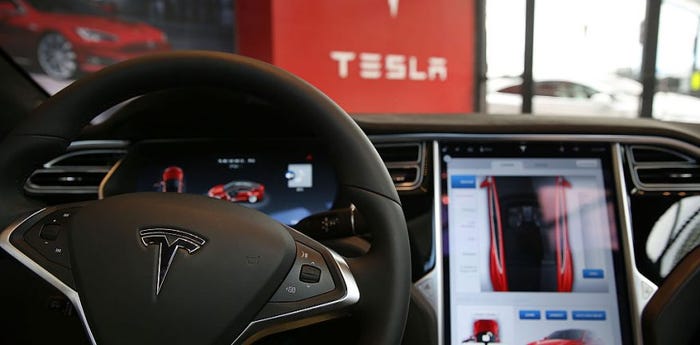Q&A: Hitachi Exec Shares His Perspective on IoT Strategy
While the Internet of Things may be a vital technological trend for industrial and enterprise companies, coming up with a solid IoT strategy remains a challenge for many.
February 10, 2018

While British technologist Kevin Ashton coined the term Internet of Things in 1999, it didn’t begin to become a buzzword until roughly five years ago. Since 2013, the technology has moved from arousing suspicion from executives at industrial and enterprise companies to winning their firm support. One of the most recent examples supporting this conclusion is a recent research report from Forbes Insights sponsored by Hitachi Vantara. While the research found executives are nearly unanimous in their views that the Internet of Things is vital to the future of their business, the number of organizations with a clear IoT strategy is rare. One of the most surprising revelations is that many executives still see IoT as an emerging technology, said Dave Parsons, vice president of IoT strategy and solutions at Hitachi Vantara. After polling more than 500 senior executives from a range of industries, Forbes Insights found that a quarter (24 percent) fail to see how IoT impacts their current business.
And for all of the talk about IT and OT integration being a vital component of IoT strategy, it is still difficult to bring the two groups together. More than half of respondents, 53 percent, reported that the CIO is the champion of IoT projects. As a traditional leader of IT initiatives, the CIO doesn’t tend to have responsibility for the OT-based operational systems and process integration that are critical for IoT success, Parsons said. “We see IoT as an architectural shift that places new requirements on technology capabilities and product categories in both the IT and OT domains,” Parsons said.
In the following Q&A, Parsons speaks about the current state of IoT adoption in the enterprise and provides advice on how companies can make sense of the quickly moving IoT ecosystem.
 What do you see as the main factors holding back successful IoT projects?
What do you see as the main factors holding back successful IoT projects?
Parsons: The IoT opportunity today is hindered by two things primarily: [the challenges of finding] the right strategy and partners to bring it to life. According to our findings, 31 percent of enterprises are challenged by cross-department cooperation, 30 percent struggle with disparate data integration and 29 percent identify skilled staff as their biggest obstacle. Despite these challenges, businesses cannot continue to stay behind. A lack of full embracement of IoT now will cause companies to miss out on insights that give a competitive edge, cut costs and accelerate business outcomes.
[Internet of Things World is where IoT is put into action, demonstrating the best case studies for every vertical, from manufacturing to the smart home. Get your tickets and free expo passes now.]
To offset these challenges and prepare a digital transformation strategy, it is important companies learn from successful deployments. Partners with knowledge and specialty skill sets are key – with 66 percent of successful implementations involving an external IoT vendor as part of the planning process and 81 percent of enterprises utilizing a third-party platform as the basis for IoT operations. By bringing the right partners to the table, organizations can execute an IoT strategy faster while ensuring current and future success for enterprises.
What is the opinion of Hitachi Vantara’s executive team regarding IoT’s potential for the industrial space?
Parsons: At Hitachi Vantara, we fully believe IoT is the future of business – with 90 percent of surveyed respondents across the globe in agreement that IoT is important to their business. The expansive IoT footprint and the broad industry applicability of IoT offers related technology providers an ability to stake justifiable claims to the multi-trillion-dollar predictions. However, IoT is better characterized as synergistic with, rather than competing against, technology capabilities such as AI, robotics and drones. While this overlap introduces room for a contributions debate of the value, in these early stages, only fractional attainment of the value opportunity overshadows the next best investment priorities for most companies. Paradoxically, it is the insights gained by analyzing the connected systems data of IoT that offers the business outcome proof needed to drive investments in more implementations.
The research found that 51 percent of companies already have significant IoT programs in operation or that the programs are a major contributor to their business; while the other half (49 percent) remain in the early stages of planning and pilot programs. The stage is set for 2018 to be the year for Industrial IoT technologies that will rapidly accelerate the transformation of disconnected factory systems to digital factories utilizing IoT data to deliver transformative results. Advanced analytics at the edge will also help companies make decisions and answer questions at unprecedented speeds and with new insights about how products are being designed, manufactured, consumed and serviced.
The current levels and increased rates of adoption gives us confidence that the continued deployment of IoT solutions in industrial settings will lead to increased savings and revenues by 2025.
The report says: “More than half of respondents—51 percent—say their company has significant IoT programs in operation or that these programs are a major contributor to their business.” How do you interpret this finding?
Parsons: A large majority of companies with over 500 employees are beginning to embrace IoT and are making enabling technologies a priority. Committing to getting started is a key milestone with one of the longest lead times, so the fact that more than half of our survey respondents said they are getting started is a good sign. Companies not only start and implement at different speeds, but the sheer number of opportunities to implement IoT solutions results in large disparity in the type of business results achieved. Even multi-year, transformative projects tend to expose results in incremental slices. What this tells us is that IoT is a transformative process, where achieving the full potential of IoT involves a “think big, start small” mentality.
According to the research, the top challenges in terms of IoT strategy include obtaining an ROI, security, cross-department cooperation, integration of disparate data and availability of skilled staff. How much of a barrier are these items to IoT deployment?
Parsons: It’s hard to say to what extent these items are slowing down deployment because these challenges should be analyzed with context. These are new business solutions, so even the most progressive companies are still learning the ins and outs of IoT — what works and what doesn’t. Dealing with “brownfield” or legacy systems is certainly a key issue driving challenges noted here like security, integration and skills. Due to the IT and OT nature of IoT solutions, we often see cross-department cooperation (due to budget tension) and security (due to risk vulnerability) as key barriers to starting projects. Conversely, availability of skilled staff and scope of data integration are key contributors to slowing projects down.
The rapid expansion of IoT tells us that companies facing these difficulties are making strides to address these challenges and move forward.
The types of leaders that are most successful in IoT implementations are those that adopt the “fail-fast” approach mentioned in the whitepaper. With this approach, companies can learn quickly from and correct mistakes. This includes assembling cross-functional teams with senior leadership sponsorship outside of IT. This collaborative leadership approach enables broader parts of the organization and reaches across multiple silos to transform a business.
[IoT World Europe in London is where industrial enterprises learn to put IoT to work and reap the commercial benefits. Get your tickets and free visitor tickets now.]
CIOs or other management personnel must look at IoT implementation through a holistic lens – one that focuses on business operations and integration, rather than just IoT. What’s more, the ideal CIO – as U.S. Bank’s Venturo points out in the study – should combine the stature and the technology expertise that drives a complex initiative forward. Finally, with 66 percent of successful IoT deployments, including an external vendor as part of the planning process, CIOs must seek out the right support to ensure success. The CIO should understand the challenges that IoT project owners face, and be able to pull in the proper experts and technology vendors to partner and address everything from cybersecurity and product design to the underlying platform that will serve as the foundation for all IoT efforts.
IoT technology moves quickly and its ecosystem is vast. What is your best advice on how firms can develop a clear path forward amidst a sometimes chaotic landscape?
Parsons: There’s no doubt that we’re in a period of rapid change, and with change comes experimentation and unpredictable obstacles. I would recommend three key tenants:
Build the business case. IoT is a digital transformation that involves changing how the business operates as a result of better operational insights. Relentlessly pursuing the benefits from the start provides the pragmatic “north star” and when delivered successfully supplies the appetite to sustain. The business case identifies the scope of change and realistic investment expectations to enable success.
Establish your collaborative ecosystem. No one player provides it all, particularly when you consider your legacy environments. Pick the partners that best support delivering on the business case and play nice with others. Enabling IoT is not just about technologies. It must include the expertise to make process change and requires collaboration with customers and suppliers with hardware, software and services skills.
Plan the implementation (think big, start small).
Think strategically – IoT requires experience and a strategic approach that takes into mind all business factors to maximize success. Fifty-three percent of successful IoT deployments have been championed by a CIO, but the collaboration mentioned above can only be accomplished with a strong cross-functional leadership team dedicated to driving business change.
Start small – IoT is a big undertaking, but there is flexibility to support experimentation and pilot programs. Sixty-six percent of successful companies report they have purposefully pursued smaller initiatives in their IoT journey. Start with a small project that has a defined return and use it to build your team, test the technology and organize your data. This will provide insight into any pain points to address to get to your goal faster.
How important is it for industrials to have case studies to help guide their deployment? How important is experimentation?
Parsons: Experimentation is important to a successful IoT program. It is helpful to learn from a role model or case study how to construct your test case. Sometimes we call these “blueprints” that can be used as a reference to make sure all the key boxes are checked. From this perspective, having a partner with a broad set of capabilities (hardware, software, services) on both the IT and OT side of the IoT solution can be a strong advantage. Partners can provide the expertise needed to solve complex issues and speed up the implementation process, or to fail-fast so that you can learn quickly and move on.
How common do you think it is for a company to use IoT technology to fuel a significant transformation of their business?
Parsons: We’ve never heard a company declare: “We are done.” Transformation is a journey and organizations are multi-level within the firm. We see clear examples of transformative value on a product line or in a functional group. However, the study has confirmed successful IoT comes with strategic partnerships, and these partnerships come with exposure to new opportunities to further transform, so the journey continues.
About the Author(s)
You May Also Like

.png?width=700&auto=webp&quality=80&disable=upscale)
.png?width=700&auto=webp&quality=80&disable=upscale)
.png?width=300&auto=webp&quality=80&disable=upscale)
.png?width=300&auto=webp&quality=80&disable=upscale)
.png?width=300&auto=webp&quality=80&disable=upscale)
